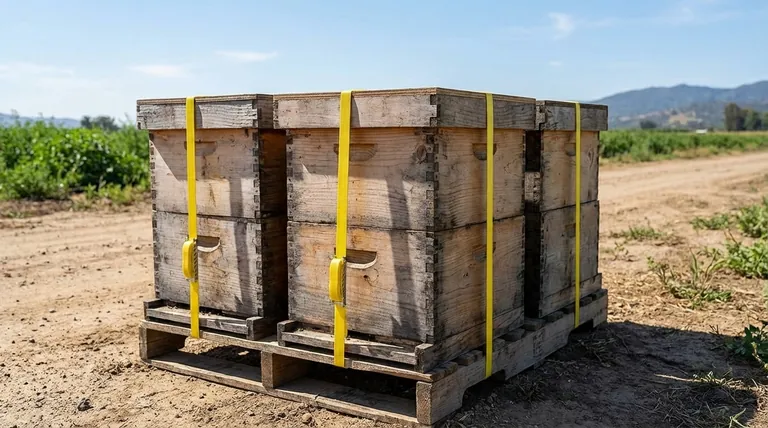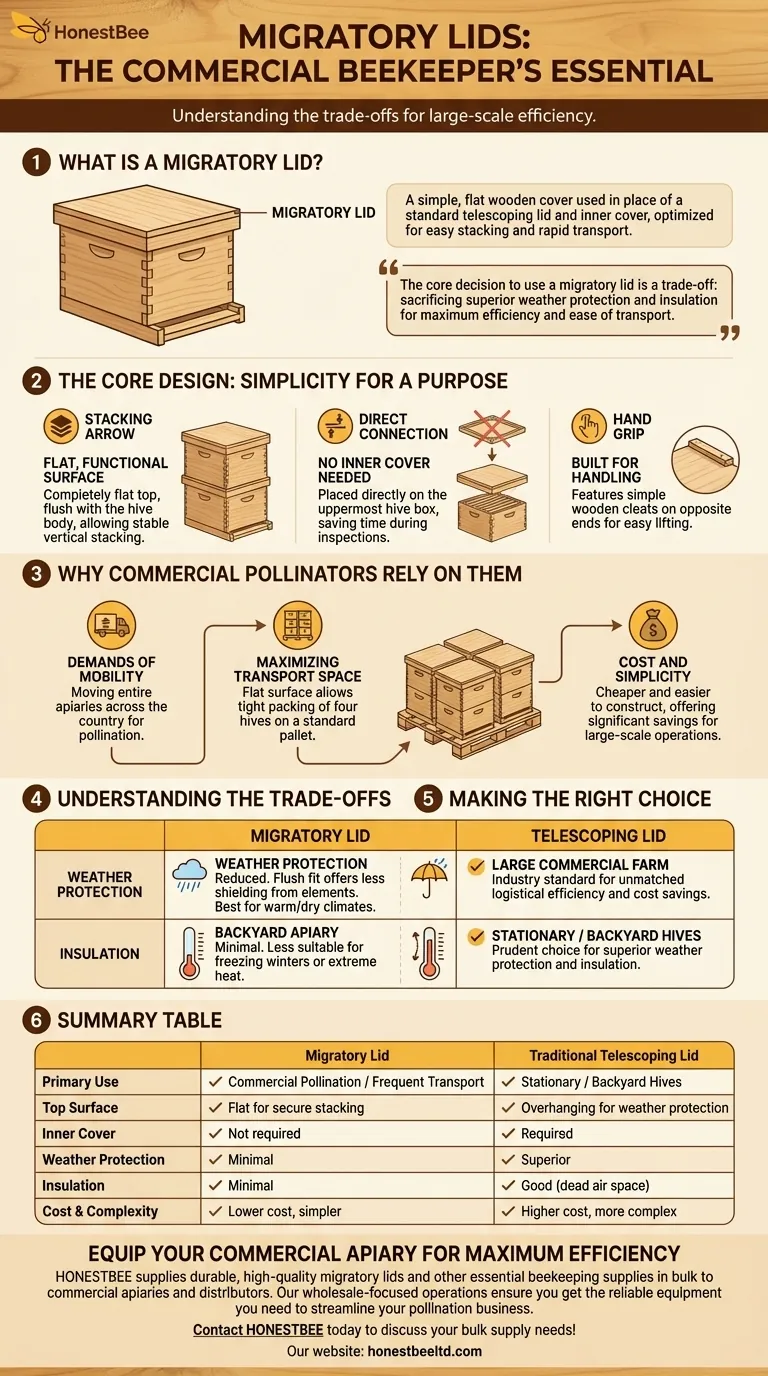In beekeeping, a migratory lid is a simple, flat wooden cover used in place of a standard telescoping lid and inner cover. Its design is stripped down to the essentials, specifically to facilitate the easy stacking and rapid transportation of beehives, making it the preferred choice for large-scale commercial pollinators.
The core decision to use a migratory lid is a trade-off. A beekeeper chooses to sacrifice the superior weather protection and insulation of a traditional telescoping lid in exchange for maximum efficiency, lower cost, and ease of transport for mobile apiaries.

The Core Design: Simplicity for a Purpose
A migratory lid's design is a direct reflection of its function. Every element is optimized for speed and transportability, contrasting sharply with the more protective designs favored by hobbyists.
A Flat, Functional Surface
The most defining feature of a migratory lid is its completely flat top. It sits flush with the dimensions of the hive body below it.
This design has one primary purpose: to allow other hives to be stacked securely on top of it. This is essential for packing hives tightly onto pallets and trucks.
No Inner Cover Needed
Unlike a standard setup, a migratory lid is placed directly on the uppermost hive box. It eliminates the need for a separate inner cover.
This simplifies the process of opening and inspecting a hive, saving valuable time when managing hundreds or thousands of colonies.
Built for Handling
Most migratory lids feature small wooden cleats or blocks on two opposite ends. These serve as simple handles for lifting the lid off the hive body.
Why Commercial Pollinators Rely on Them
The migratory lid is the unofficial standard for any beekeeper who moves hives as part of their business. This is due to a confluence of economic and logistical advantages.
The Demands of Mobility
Commercial pollination involves moving entire apiaries across the country to service agricultural crops. Efficiency in this process is paramount.
The ability to stack hives flush against each other is not a minor convenience; it is a core business requirement.
Maximizing Transport Space
A standard pallet can typically hold four beehives. The flat surface of the migratory lid is what makes this configuration stable and possible.
This density dramatically reduces transportation costs and allows for the movement of more colonies with fewer resources.
Cost and Simplicity
Migratory lids are cheaper and easier to construct than their telescoping counterparts. When outfitting thousands of hives, this cost savings is substantial.
Understanding the Trade-offs
Choosing a migratory lid involves accepting significant compromises, particularly regarding hive protection.
Reduced Weather Protection
A telescoping lid overhangs the hive body, shielding the hive's joints from rain and wind. A migratory lid sits flush, offering far less protection from the elements.
This is why migratory lids are most common in warmer, drier climates where harsh weather is less of a concern.
Less Insulation
The standard telescoping lid and inner cover combination creates a pocket of dead air. This provides crucial insulation against both heat and cold.
A migratory lid offers minimal insulation, making it less suitable for regions with freezing winters or extreme summer temperatures.
Making the Right Choice for Your Apiary
The choice between a migratory lid and a telescoping lid comes down to the fundamental purpose of your beekeeping operation.
- If your primary focus is large-scale pollination or moving hives frequently: The migratory lid is the industry standard, providing unmatched logistical efficiency and cost savings.
- If your primary focus is backyard beekeeping or managing stationary hives in a variable climate: The superior weather protection and insulation of a telescoping lid with an inner cover is the more prudent choice.
Ultimately, understanding the function of your equipment allows you to build a hive that is perfectly suited to its environment and your goals.
Summary Table:
| Feature | Migratory Lid | Traditional Telescoping Lid |
|---|---|---|
| Primary Use | Commercial Pollination / Frequent Transport | Stationary / Backyard Hives |
| Top Surface | Flat for secure stacking | Overhanging for weather protection |
| Inner Cover | Not required | Required |
| Weather Protection | Minimal | Superior |
| Insulation | Minimal | Good (dead air space) |
| Cost & Complexity | Lower cost, simpler | Higher cost, more complex |
Equip your commercial apiary for maximum efficiency. HONESTBEE supplies durable, high-quality migratory lids and other essential beekeeping supplies in bulk to commercial apiaries and distributors. Our wholesale-focused operations ensure you get the reliable equipment you need to streamline your pollination business. Contact HONESTBEE today to discuss your bulk supply needs!
Visual Guide

Related Products
- Professional Galvanized Hive Strap with Secure Locking Buckle for Beekeeping
- Inner Beehive Cover for Beekeeping Bee Hive Inner Cover
- Long Langstroth Style Horizontal Top Bar Hive for Wholesale
- Professional Engraved Round Hive Number Tags for Beekeeping
- Stainless Steel Beekeeping Honey Extractor Lid
People Also Ask
- Can straps with hook ends be used for beehives? A Guide to Secure Hive Management
- What are the two styles of hive straps? Choose the Right Strap for Your Hive Security
- What maintenance is required for hive straps? A Guide to Cam Buckle vs. Ratchet Strap Care
- How can beekeepers secure the top cover of a hive? Protect Your Colony from Wind and Weather
- How should a cam buckle strap be installed for optimal performance? Master the Leverage for Maximum Tension



















